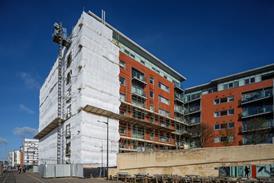Michael Poulsom considers what constitutes a ‘green lease’ and outlines some of the complexities in drafting them
The broad concept of a ‘green lease’, comprising a landlord / tenant relationship directly or indirectly encouraging or requiring the parties to adopt sustainable practices, is well recognised. The precise detail of what such leases include and how they operate, however, is both evolving and, to a certain degree, subjective. In the absence of any legal requirement in the UK to use green leases, or to include green clauses, there are no standardised forms of wording. Accordingly, a degree of uncertainty as to whether a lease can properly be described as ‘green’ remains.

Evolving definitions of green leases
What amounts to a green lease appears to be changing. Historically, broad, aspirational and non-binding commitments, within or outside a lease, were apparently sufficient to categorise a broad landlord / tenant relationship as ‘green’. Green provisions could be binding or not binding, inside or outside the lease document, imposed temporarily or for the lease’s duration, personal to a particular tenant, or subject to unilateral termination.
Guidance from the Better Buildings Partnership (BBP), revised in 2024, suggests this flexible definition of a green lease may now be incorrect. The BBP defines a green lease as “a standard form lease with additional clauses … provid[ing] for the management and improvement of environmental … performance of the building by both owner and occupier(s)”. It states that “such a document is legally binding”, that “its provisions remain in place for the duration of the term” and that it “represents the firm commitment, of both owner and occupiers, to take action on sustainability”.
A retreat from memoranda of understanding
Until recently, the creation of green leases by the annexation to conventional lease documents (whether containing green provisions or not) of non-binding memoranda of understanding (MoU) appears to have been a widely approved and adopted practice. Precedent MoU, produced until 2024 by the BBP, and at the time of writing still available for use by practitioners leasing NHS property, enabled the creation of a green lease by the simple addition of another document.
The creation of green leases by appending MoU to otherwise conventional lease documents confers several advantages:
- Guidance from, for example, the BBP and the NHS gave this practice a certain ‘approved’ status.
- MoU can be drafted independently of the lease itself, have no direct reference to specific provisions in the lease, can be readily amended or revoked, can be personal to the parties, and – unlike, for example, leases exceeding seven years, which require registration – remain confidential.
- MoU can be annexed to an existing lease without the need for a comprehensive deed of variation or surrender and regrant.
- The non-binding nature of MoU may make them more attractive to lease parties, who might feel that they can complete (and advertise that they have completed) green leases without incurring binding obligations.
The BBP’s revised 2024 definition of a green lease, with its emphasis on binding provisions, highlights weaknesses in this drafting method. Such weaknesses, although not routinely stated expressly, might include the following:
- Precedent MoU typically state that they are non-binding. The NHS MoU (in turn based on a BBP MoU) expressly states that it is “not supplementary or collateral to the lease … is not to be taken into account when construing the provisions of the lease and [such] provisions … shall prevail over anything in [the] MoU”. The inclusion of such wording in the parties’ agreed documentation potentially casts doubt on the genuine commitment to pursuing environmental goals. This weakness is aggravated by the confidential, personal, amendable and revocable nature of MoU, and by their absence from any public record
- Whether non-binding, non-supplemental and non-collateral commitments made in MoU can be separated completely from binding lease commitments remains legally unclear: Prenn v Simmonds [1971] 1 WLR 1381 at 1384–6 establishes that interpretation of a legal document requires ascertaining its meaning to someone “having all the background knowledge … reasonably available to … parties in the situation in which they were at the time of the contract” (per Lord Wilberforce). The “matrix of fact”, comprising the factual background which influences the interpretative process, was held in Investors Compensation Scheme Ltd v West Bromwich Building Society [1998] 1 WLR 896 at 912 to include “absolutely anything which would have affected the way in which the … document would have been understood” (per Lord Hoffmann). Evidently, therefore, and possibly contrary to the expressed intentions of the parties, the existence of a MoU might affect the interpretation of the lease that it accompanies, but the extent to which it does so, and the consequences of this effect, remain unknown.
It may be that the MoU approach can now only be justified where a lease has been completed and the parties wish to enter into new sustainability provisions.
From MoU to bespoke lease drafting
Any message encouraging greater engagement with green lease drafting practices is of limited utility if it remains in the realm of aspiration or general principle. Commercial property practitioners are accustomed to drafting lease documents in which provisions are highly interconnected, and to detailed negotiations over individual clauses, phrases or words. Lease drafting and negotiation are characterised by close attention to detail, to which the application of generalised aspiration is unhelpful. Practitioners understandably require guidance on what precisely it is that they should be doing or changing.
One difficulty is that many sample green provisions, especially those found in precedent MoU, appear ill-suited to inclusion in a binding lease. For example, the following provisions resemble general statements of intent more properly found in heads of terms:
- Parties must “establish a forum for dialogue … on reviewing environmental performance and identifying opportunities for improvement”.
- Parties must “give reasonable consideration to … the environmental performance and impact of all … alterations”.
- Parties must “so far as is practicable [to] have regard to environmental good practice, energy and water efficiency and waste reduction …”.
Often comprising little more than ‘agreements to agree’, they appear unfamiliar to practitioners used to the detail of specific binding provisions.
Even if parties were willing to accept such provisions in a lease, questions of what exactly those parties need to do to comply with the lease are left unanswered. Consequently, the parties do not know what would amount to a breach, or what the consequences of an alleged or actual breach might be. Direct consequences might be remedies of damages or forfeiture, or resort to a rent deposit deed or authorised guarantee agreement. Indirect consequences of a breach might be adverse effects on rent review or on renewal, or determination of the reasonableness or otherwise of withholding consent for alienation.
The process of creating a greener lease should be thought of not as a comprehensive or standardised process (as historically has been the rationale behind the annexation to leases of standard form MoU), but as an incremental one. The BBP is clear that the process of creating green or greener leases involves the careful selection of clauses to add or amend, rather than the wholesale replacement of conventional leases with green versions. Practitioners might introduce or add to their standard form leases a small number of binding clauses (thereby adhering both to the recognised nature of a lease and the BBP’s revised guidance). The precise process of adding new clauses, or of amending existing clauses, would facilitate full consideration of the effect of those additions or amendments on other lease provisions, such as those pertaining to defined terms, repairs, rent review, alienation, service charges, rent suspension and forfeiture.
To illustrate, amendments might be made to clauses regulating tenants’ alterations. Conventional leases typically allow limited alterations with the landlord’s prior written consent, while allowing or absolutely prohibiting others. Following this ‘orthodox’ approach, the BBP provides model “light green” and “medium green” clauses. Both prohibit the tenant from making alterations or additions to the premises unless it has first given the landlord sufficiently detailed specifications of the proposed work to enable its effect on the environmental performance (a defined term) or any energy performance certificate (EPC) or environmental rating (also defined) of the premises or the building to be accurately assessed. The light green version then permits works which would reasonably be expected adversely to affect that performance or those ratings with the landlord’s written consent. The medium green version prohibits any such works. Both versions then require the tenant, on completion of the works, to give the landlord “as built” drawings and specifications of the completed works to allow assessment of their impact.
In relation to the ease with which such clauses might be incorporated into leases, a distinction can be drawn here between new lettings and renewals. On new lettings, the careful and gradual adoption of such relatively conventional and recognisable clauses, quite different in ‘tone’ and content from the aspirational and uncertain provisions of precedent form MoU, appears realistic. This drafting approach might feasibly be extended into other areas of leases, for example repairs, service charges and covenants relating to tenants’ use of premises.
Judicial acceptance of green clauses
A material consideration, however, is how far, on renewal of existing leases under the Landlord and Tenant Act 1954 (LTA 1954), courts will support the introduction of new green clauses. Section 35(1) LTA 1954 explicitly allows the inclusion of new lease terms “as may be agreed between the landlord and the tenant”. Where a party resists the inclusion of new clauses, their inclusion “may be determined by the court; in determining those terms the court shall have regard to the terms of the current tenancy and to all relevant circumstances”.
Limited evidence indicates that courts may support the gradual adoption of green clauses on LTA 1954 renewal. In Clipper Logistics plc v Scottish Equitable plc (Sheffield County Court, 7 March 2022), the landlord sought a determination on the insertion into a lease of three new clauses. The court rejected the inclusion of clauses preventing the tenant from making alterations which caused the property’s EPC rating to fall below Band E, and requiring the tenant to indemnify the landlord against the cost of a new EPC in the event of such works.
The court did, however, accept the inclusion of a reinstatement clause requiring the tenant to maintain the current EPC rating throughout the tenancy and to implement remedial works to achieve this.
The rejection of the aspirational / non-binding MoU approach and an acceptance of the relative ease with which green clauses can be drafted, as well as emerging judicial support for their inclusion, may make the development of greener leases more commercially acceptable and practically attainable.




















